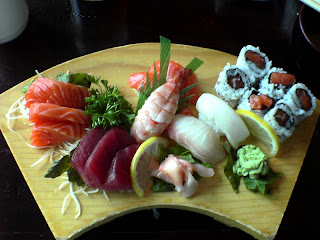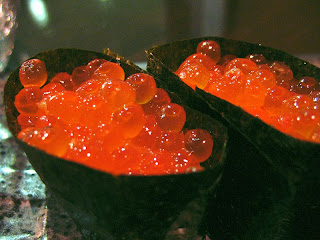 fatty tuna belly
fatty tuna belly sushi
sushiThere are various types of sushi: sushi served rolled inside nori (dried and pressed layer sheets of seaweed or alga) called makizushi (巻き) or rolls; sushi made with toppings laid with hand-formed clumps of rice called nigirizushi (にぎり); toppings stuffed into a small pouch of fried tofu called inarizushi; and toppings served scattered over a bowl of sushi rice called chirashi-zushi (ちらし).
1. Nigiri-zushi (握り寿司, "hand-formed sushi").
This is the most typical form of sushi in restaurants. It consists of an oblong mound of sushi rice that is pressed between the palms of the hands, with a speck of wasabi and a slice of topping called neta draped over it. This is possibly bound with a thin band of nori, and is often served in pairs.
Gunkan-maki (軍艦巻, "warship roll") is a special type of nigiri-zushi: an oval, hand-formed clump of sushi rice that has a strip of nori wrapped around its perimeter to form a vessel that is filled in with topping(s). The topping is typically some soft, loose or fine-chopped ingredient that requires the confinement of nori such as roe, natto, oysters, and quail eggs.
2. Makizushi (巻き寿司, "rolled sushi").
Makizushi is a cylindrical piece, formed with the help of a bamboo mat. Makizushi is generally wrapped in nori, but can occasionally be found wrapped in a thin omelette, sesame seeds, cucumber, or parsley. Makizushi is usually cut into six or eight pieces, which constitutes an order. Here are some common types of makizushi, but many other kinds exist.


- Futomaki (太巻き, "large or fat rolls") is a large cylindrical piece, with nori on the outside. A typical futomaki is three or four centimeters (1.5 in) in diameter. They are often made with two or three fillings that are chosen for their complementary tastes and colors. Futomaki is generally vegetarian, but may include toppings such as tiny fish eggs.
- Hosomaki (細巻き, "thin rolls")is a small cylindrical piece, with the nori on the outside. A typical hosomaki has a diameter of about two centimeters (0.75 in). They generally contain only one filling, often tuna, cucumber, kanpyō, thinly sliced carrots, or, more recently, avocado. Kappamaki, (河童巻き) a kind of Hosomaki filled with cucumber, is named after the Japanese legendary water imp fond of cucumbers called the kappa. Traditionally, Kappamaki is consumed to clear the palate between eating raw fish and other kinds of food, so that the flavors of the fish are distinct from the tastes of other foods.
- Tekkamaki (鉄火巻き) is a kind of Hosomaki filled with raw tuna. Although some believe that the name "Tekka", meaning 'red hot iron', alludes to the color of the tuna flesh, it actually originated as a quick snack to eat in gambling dens called "Tekkaba (鉄火場)", much like the sandwich.
- Uramaki (裏巻き, "inside-out rolls") is a medium-sized cylindrical piece, with two or more fillings. Uramaki differs from other maki because the rice is on the outside and the nori inside. The filling is in the center surrounded by nori, then a layer of rice, and an outer coating of some other ingredients such as roe or toasted sesame seeds. It can be made with different fillings such as tuna, crab meat, avocado, mayonnaise, cucumber, carrots. This is typically thought of as an invention to suit the American palate, and is not commonly seen in Japan. The increasing popularity of sushi in North America, as well as around the world, has resulted in numerous kinds of uramaki and regional off-shoots being created, such as the California roll.
- Temaki (手巻き, "hand rolls") is a large cone-shaped piece of nori on the outside and the ingredients spilling out the wide end. A typical temaki is about ten centimeters (4 in) long, and is eaten with fingers because it is too awkward to pick it up with chopsticks. For optimal taste and texture, Temaki must be eaten quickly after being made because the nori cone soon absorbs moisture from the filling and loses its crispness and becomes somewhat difficult to bite.
- Inari-zushi (稲荷寿司, "stuffed sushi") is a pouch of fried tofu filled with usually just sushi rice. It is named after the Shinto god Inari, who is believed to have a fondness for fried tofu.


3. Oshizushi (押し寿司, "pressed sushi") is a block-shaped piece formed using a wooden mold, called an oshibako. The chef lines the bottom of the oshibako with the toppings, covers them with sushi rice, and then presses the lid of the mold down to create a compact, rectilinear block. The block is removed from the mold and then cut into bite-sized pieces.

4. Chirashizushi (ちらし寿司, "scattered sushi") is a bowl of sushi rice with other ingredients mixed in (also refers to barazushi). It is commonly eaten in Japan because it is filling, fast and easy to make. Chirashizushi most often varies regionally because it is eaten annually as a part of the Doll Festival, celebrated only during March in Japan.
5. Narezushi (熟れ寿司, "matured sushi") is an older form of sushi. Skinned and gutted fish are stuffed with salt, placed in a wooden barrel, doused with salt again, and then weighed down with a heavy tsukemonoishi (pickling stone). They are supposedly salted for ten days to a month, then placed in water for 15 minutes to an hour. They are then placed in another barrel, sandwiched, and layered with cooled steamed rice and fish. Then the mixture is again partially sealed with otoshibuta and a pickling stone. As days pass, water seeps out, which must be removed. Six months later, this funazushi can be eaten, and remains edible for another six months or more.
6. Temarizushi are ball-shaped sushi made by pressing rice and fish into a ball-shaped form by hand using a plastic wrap. They are quite easy to make and thus a good starting point for beginners.
No comments:
Post a Comment